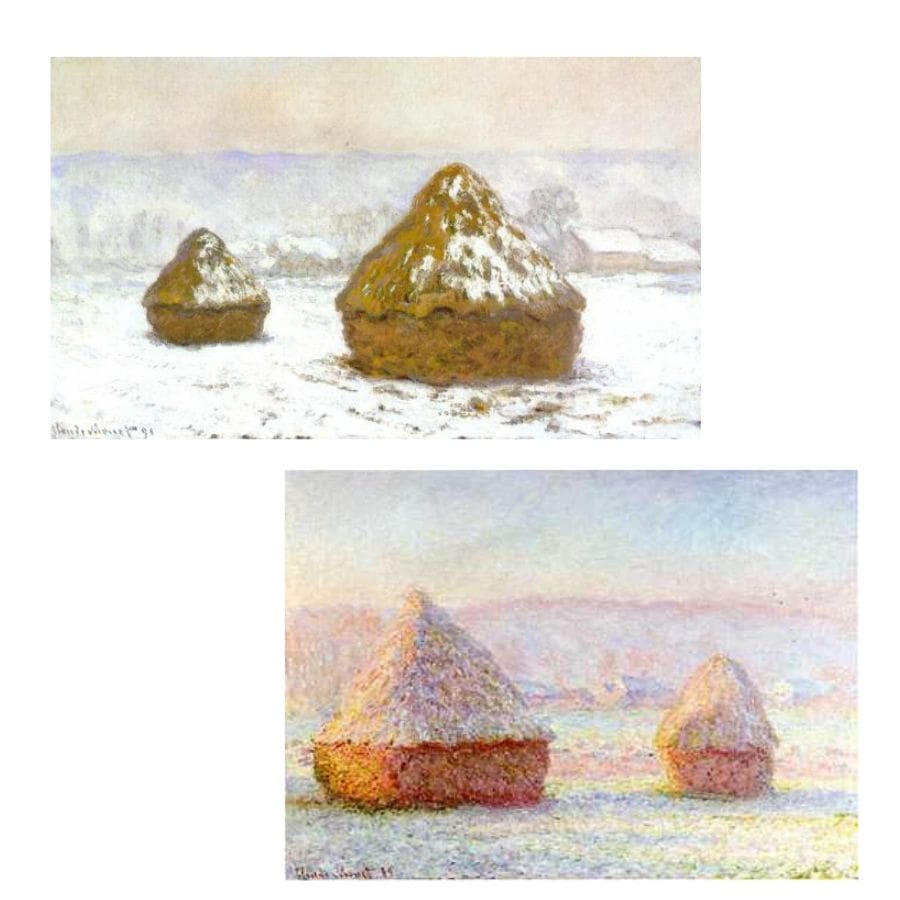One would describe a haystack as a pile or bundle of hay in a field often left at a side. With the scenery with which one would just be able to glorify the warm fields of the cool breeze passing over it, haystacks often remain as the backdrop of such scenic beauties.
However, from the French painter Claude Monet’s perspective, it was the opposite. His ideation was focused on haystacks he painted a series of impressionist paintings all with the principal subject being haystacks. Haystacks by Claude Monet is one of this most popular creations.
About the Painting
The title “Haystacks” primarily refers to a series of twenty-five paintings, the principal subject of each painting being the stacks of harvested wheat which Monet began painting near the end of the summer of 1890 and continued through the following spring.
This series has gained popularity as the painter repeated the same subjects to highlight the differing lights and atmosphere at different times of day, across the seasons and in many types of weather.
The series is largest collected at the Musee d’Orsay and Musee Marmottan Monet in Paris, and in the Art Institute of Chicago. Other collections include the Museum of Fine Art in New York and the National Museum of Western Art in Tokyo amongst the notable places where the paintings reside.
History of the Painting
Haystacks is a series widely known for its thematic use of repetition to the difference in perception of light across various times, seasons, and types of weather. The paintings were made with the haystack placed just outside Monet’s house in Giverny.
Interestingly, all the paintings made by Monet after settling in Giverny in 1883 were scenes within 3 kilometers of his home. He was truly artistic and was fascinated by the visual nuances of the region’s landscape and the variations in the seasons.
During the eighteen months, between 1890 and 1891, Monet focused on the subject matter, i.e., the haystack outside his house, and created around 30 paintings. Out of the 30 paintings, 5 of them are considered a predecessor of the series “Haystacks”.
During his struggle with painting, Monet described the various obstacles he faced during making one of his most notable works. He would struggle with the varying lighting on the stack during summers, saying how the sun would set faster for him to capture its true essence over the abandoned haystack. He is found to admit that a lot of work was indeed necessary to succeed with the goal he desired.
After overcoming his struggles, he was able to perfectly capture the haystacks in winter daylight with violet and orange hues, covered in snow, with a hint of the brown hay underneath.

What the Painting Shows
It was a vibrant portrayal of a simple yet effective subject showing Monet’s brilliance in capturing the effect of light in varying seasons. Influenced by Monet’s incredible painting series, Vincent Van Gogh also created his version of Haystacks.
Along with the transitions in various lighting conditions and seasons for a haystack, the series was also able to depict Monet’s mastery of brushwork, colors and his dedication to capturing the nuances of nature. Though, Monet’s fascination with enrapturing the effects of light and atmosphere is pretty evident in the Haystack series.
The painting was executed outdoors, allowing the artist to observe and depict the haystacks under different lighting conditions and various atmospheric effects. Monet’s goal was to capture the effect of varying atmospheric effects on the haystack.
The haystacks were the primary subjects which were depicted in various sizes, shapes, and arrangements, occupying the foreground or the middle ground of the composition.

What Makes the Painting Special?
Monet’s eye was sensitive to details which were evident with the intricate variations. He made it for color, texture and form within the haystacks. Despite the seemingly mundane subject matter, Moent was able to transform these agricultural structures into mesmerizing structures of light, color and form.
The series also showcases Monet’s profound understanding of color theory. He skillfully employed a vibrant and diverse palette to denote the haystacks and their surroundings. In some paintings, the haystacks were rendered in warm hues of gold and ochre, while in others, color tones of blue and purple dominate. This vibrant use of colors not only reflects the changing seasons but also creates a deep sense of depth and atmosphere within the compositions.
The Essence of the Poem
The Haystacks series also exemplifies Monet’s fascination with the exploration of light and its effect on the landscape. Sunrise and sunset scenes feature warm, soft hues, with the haystacks bathed in golden light while, in contrast, midday scenes showcase intense sunlight, casting sharp shadows and highlighting the textural details of the haystacks.
The brushwork in the series is also characteristic of Monet’s impressionist style. The loose, broken and visible brushstrokes are employed to the play of light and atmosphere which are employed to capture the play of light and atmosphere.
In recent times, the Haystacks series remains a celebrated body of art in which Monet righteously showcases his dedication to capturing the essence of nature and its transient beauty.
The series is widely admired for its technical virtuosity and its ability to evoke a sense of wonder and contemplation for the artist that invites the viewers to appreciate the ordinary, inviting them to see the haystacks in a new light and examine the beauty inherent in everyday scenes.
These paintings continue to inspire artists and art enthusiasts and serve as a testament to Monet’s enduring legacy and his profound impact on the art world.
Also read: The Evolution of Abstract Expressionism

